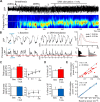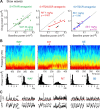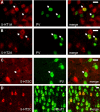Serotonin modulates fast-spiking interneuron and synchronous activity in the rat prefrontal cortex through 5-HT1A and 5-HT2A receptors
- PMID: 20147548
- PMCID: PMC6634052
- DOI: 10.1523/JNEUROSCI.3335-09.2010
Serotonin modulates fast-spiking interneuron and synchronous activity in the rat prefrontal cortex through 5-HT1A and 5-HT2A receptors
Abstract
Alterations of the serotonergic system in the prefrontal cortex (PFC) are implicated in psychiatric disorders such as schizophrenia and depression. Although abnormal synchronous activity is observed in the PFC of these patients, little is known about the role of serotonin (5-HT) in cortical synchrony. We found that 5-HT, released by electrical stimulation of the dorsal raphe nucleus (DRN) in anesthetized rats, regulates the frequency and the amplitude of slow (<2 Hz) waves in the PFC via 5-HT(2A) receptors (5-HT(2A)Rs). 5-HT also modulates prefrontal gamma (30-80 Hz) rhythms through both 5-HT(1A)Rs and 5-HT(2A)Rs, but not 5-HT(2C)Rs, inducing an overall decrease in the amplitude of gamma oscillations. Because fast-spiking interneurons (FSi) are involved in the generation of gamma waves, we examined serotonergic modulation of FSi activity in vivo. Most FSi are inhibited by serotonin through 5-HT(1A)Rs, while a minority is activated by 5-HT(2A)Rs, and not 5-HT(2C)Rs. In situ hybridization histochemistry confirmed that distinct populations of FSi in the PFC express 5-HT(1A)Rs and 5-HT(2A)Rs, and that the number of FSi expressing 5-HT(2C)Rs is negligible. We conclude that 5-HT exerts a potent control on slow and gamma oscillations in the PFC. On the one hand, it shapes the frequency and amplitude of slow waves through 5-HT(2A)Rs. On the other hand, it finely tunes the amplitude of gamma oscillations through 5-HT(2A)R- and 5-HT(1A)R-expressing FSi, although it primarily downregulates gamma waves via the latter population. These results may provide insight into impaired serotonergic control of network activity in psychiatric illnesses such as schizophrenia and depression.
Figures







References
-
- Aghajanian GK, Marek GJ. Serotonin, via 5-HT2a receptors, increases EPSCs in layer V pyramidal cells of prefrontal cortex by an asynchronous mode of glutamate release. Brain Res. 1999;825:161–171. - PubMed
-
- Amargós-Bosch M, Bortolozzi A, Puig MV, Serrats J, Adell A, Celada P, Toth M, Mengod G, Artigas F. Co-expression and in vivo interaction of serotonin1A and serotonin2A receptors in pyramidal neurons of prefrontal cortex. Cereb Cortex. 2004;14:281–299. - PubMed
-
- Aznar S, Qian Z, Shah R, Rahbek B, Knudsen GM. The 5-HT1A serotonin receptor is located on calbindin- and parvalbumin-containing neurons in the rat brain. Brain Res. 2003;959:58–67. - PubMed
-
- Bartos M, Vida I, Jonas P. Synaptic mechanisms of synchronized gamma oscillations in inhibitory interneuron networks. Nat Rev Neurosci. 2007;8:45–56. - PubMed
-
- Başar E, Güntekin B. A review of brain oscillations in cognitive disorders and the role of neurotransmitters. Brain Res. 2008;1235:172–193. - PubMed
Publication types
MeSH terms
Substances
LinkOut - more resources
Full Text Sources
Miscellaneous
